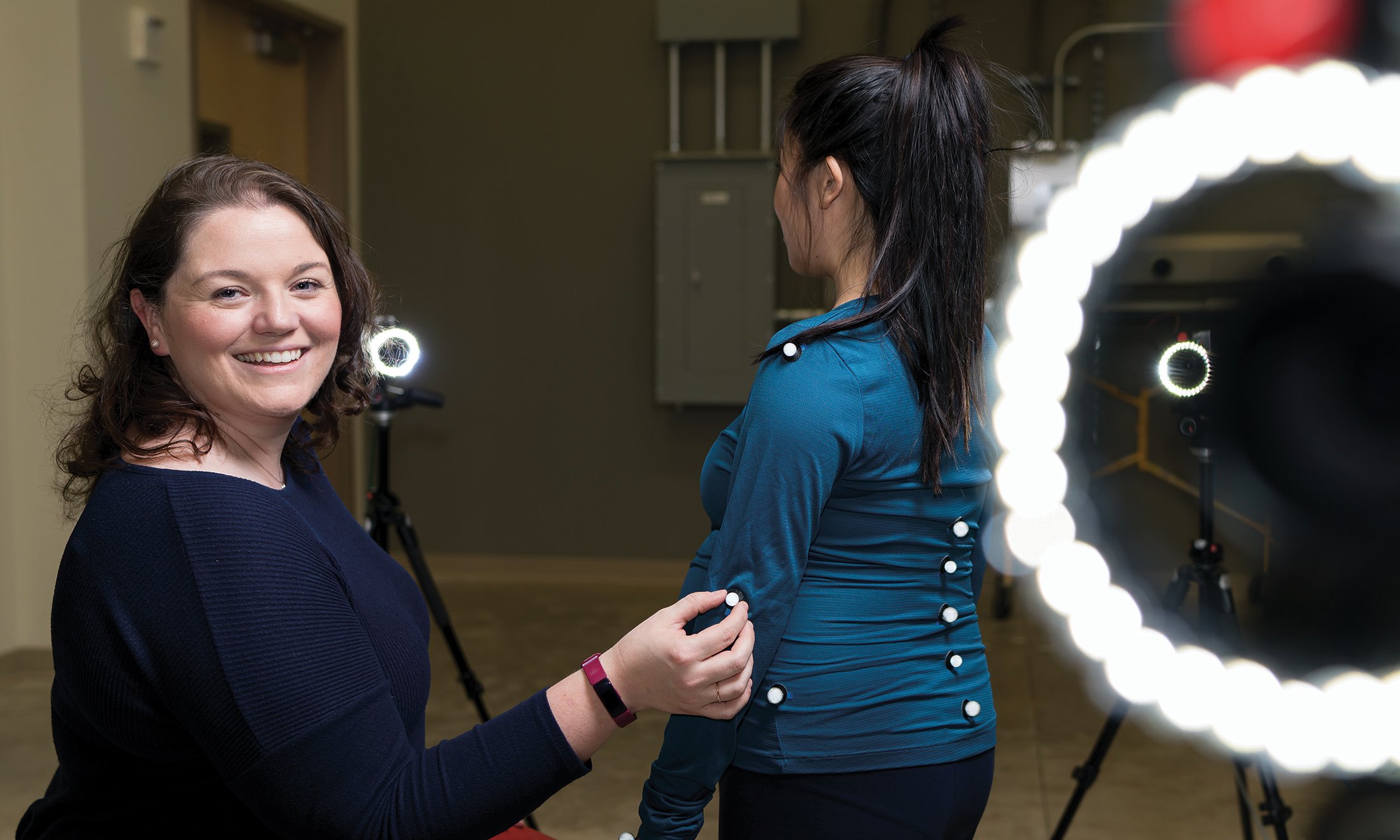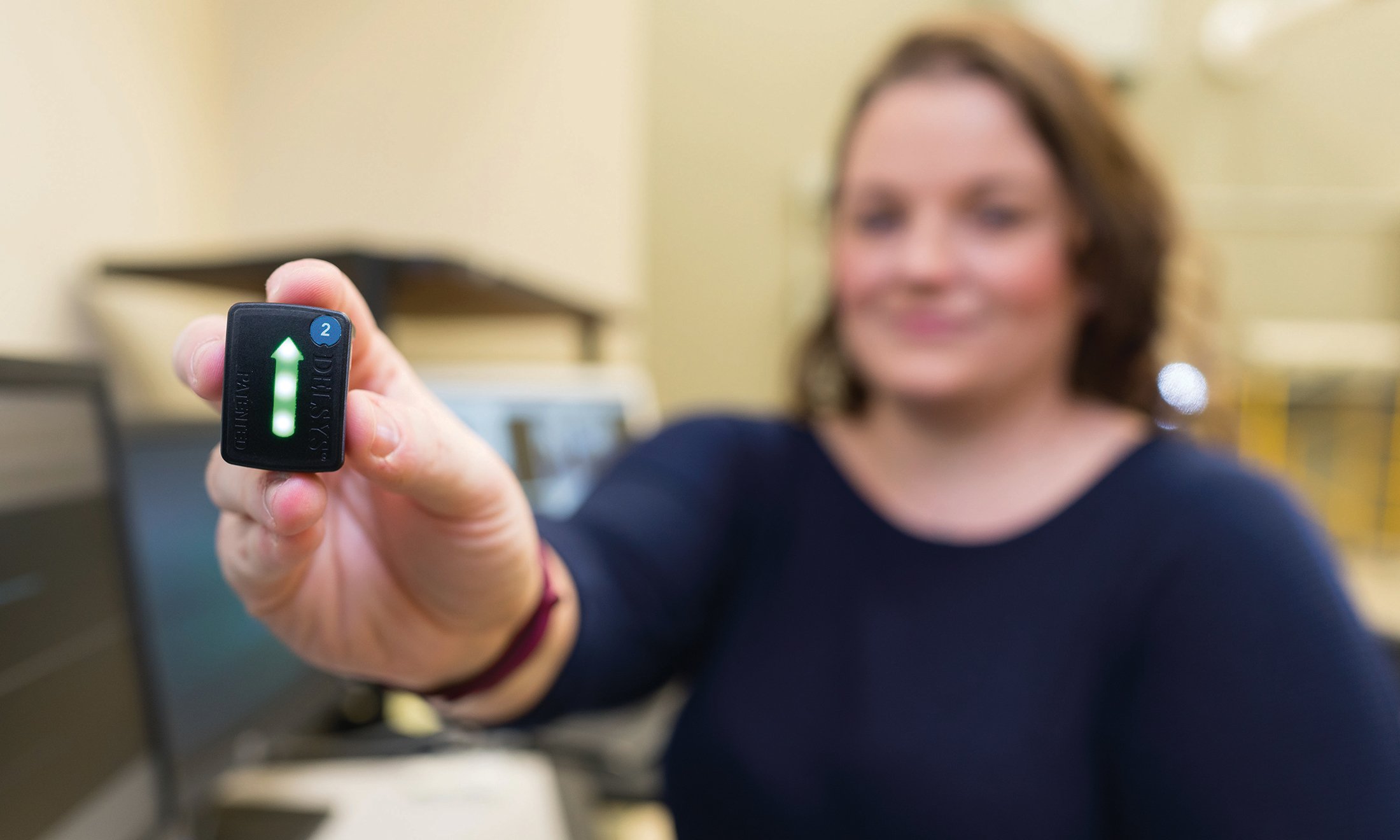Researching Through A Pandemic
OU Assistant Professor Tara Diesbourg, Ph.D., researches the hazards of sitting

OU School of Health Sciences Assistant Professor Tara Diesbourg, Ph.D. (Photo Credit: Robert Hall)

Dr. Diesbourg uses a Delsys Trigno wireless EMG sensor to help measure muscle activity and segment accelerations. This quantitative information supplements the qualitative surveys researchers distributed during the pandemic as social distancing halted in-person research. (Photo Credit: Robert Hall)
At the beginning of the COVID-19 pandemic, many Americans started working from home to avoid spreading the virus at work. But there’s an issue that comes with working from home that’s hazardous to one’s health as well — sitting.
According to the Pew Research Center, 71 percent of polled Americans had their jobs moved to their home office during the quarantine. This led to changing work habits for most workers. Sitting at a desk in Zoom meetings all day, working longer hours and having no physical office are all things that changed during this seismic shift in work life. With this in mind, the physical repercussions of these work habits have become an important fact to study.
One figure at the forefront of this study is Tara Diesbourg, Ph.D. Dr. Diesbourg completed her Honours Bachelor of Human Kinetics degree with a concentration in Movement Science at
the University of Windsor, before attaining her Ph.D. at Queen’s University in Kingston, Ontario. Now an assistant professor at Oakland University, Dr. Diesbourg primarily focuses her research on ergonomics (the fit and compatibility of people within their environment) and occupational safety.
Prior to the pandemic, Dr. Diesbourg had planned to continue her work looking at changes in the stiffness of the tissues of the spine in different populations and how this might increase a person’s risk for injury at work. Her work was put on hold when in-person research was suspended due to the pandemic. While previously, researchers were able to measure subjects’ muscle activity and posture and observe their participants first-hand, supplementing this information with questionnaires and surveys, during the pandemic, surveys and second-hand data were some of the few ways to keep the research moving forward.
“Now I’m relying a lot more on self-reported information than ever before. That’s also fine and useful, however. What the person is perceiving could be completely different than what I would perceive,” says Dr. Diesbourg. “It’s quite interesting to see differing opinions where some might find that lifting five pounds is actually quite heavy while others report the opposite. Before, I may not have asked that question, but now I have the opportunity to drill down to find where these differences are coming from.”
Self-reporting comes with its challenges, however. It’s difficult for Dr. Diesbourg and her fellow researchers to predict the amount of feedback they’ll get, and they often receive fewer responses than anticipated. The range of responses also varies greatly, as different respondents have their own unique interpretation of what they’re being asked. Dr. Diesbourg says that this results in her team needing to be a bit more creative when reading data.
“We’re finding that we have less statistical power, so comparing our data and research has taken a lot more creativity. We’re having to take more factors into account and control for more relationships between variables than we previously might have.”
Despite these limitations, Dr. Diesbourg has managed to persevere and continue to create ground-breaking research. She is currently working with a team at her alma mater of Queen’s University to compare how employee health has changed since the beginning of the pandemic due to working from home.
Another of her research endeavors focuses on what Dr. Diesbourg calls “extreme sitting” for people that are required to sit for unusually long periods of time. This survey focuses on Varsity E-Sports players across the country who spend long hours sitting to play their chosen video game, while also working and learning from home.
While these studies are not far enough along to report statistical findings, Dr. Diesbourg says there does seem to be a trend towards increased reports of pain with increased sitting, but the exact cause and nature of this increase is unclear.
“The risks of a sedentary lifestyle include cardiovascular problems, diabetes, muscle atrophy and many more negative effects that impact a person’s life.”
How can people combat this reality while working from home? Dr. Diesbourg says that it’s impossible to completely avoid sitting, but a few tactics can improve their physical health.
“Break up the time you spend sitting with some standing breaks. Deliberately make time to stand up from your chair, stretch, walk around or get a drink. You have to allow your body to reset before getting back to seated work again. Instead of sitting and working on something for hours on end, set a timer to go off every 45 minutes or so to stand up and walk around for a few minutes before getting back to your work. It won’t affect your productivity much, but you will feel better physically.”
With an increasing number of people being required to sit at their desks all day, Dr. Diesbourg’s research is poised to be important moving into the future.


 September 10, 2021
September 10, 2021 By Robert Brent
By Robert Brent

